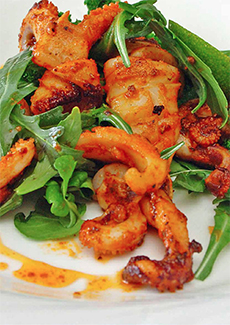




| Home | Features | Club Nights | Underwater Pics | Feedback | Non-Celebrity Diver | Events | 8 August 2025 |
| Blog | Archive | Medical FAQs | Competitions | Travel Offers | The Crew | Contact Us | MDC | LDC |

|

|
 
 |
 ISSUE 19 ARCHIVE - COOKING THE CATCH: GRILLED SQUID WITH PEPPERY SALADAndrew MaxwellOne of my most memorable dives was a couple of years ago on Elphinstone reef in the Red Sea – we stood on the boat, watching five beautiful oceanic whitetips circling under the boat and of course we could not resist the opportunity to experience being in the water with these beautiful, beautiful fish. As we hovered at around 5 meters under the boat, I watched one of the sharks slowly swim towards one of the members of our group – a 15 year old girl, on a summer diving trip with her father – and it kept getting closer and closer. The rest of us could feel the tension and it was not until the shark's nose was a matter of inches away from her mask that it gracefully glided above her.So it was with great pleasure that I welcomed the news that delegates at the Convention on International Trade in Endangered Species (CITES) conference in Bangkok voted to extend their protection to oceanic whitetips, whose numbers have declined dramatically in recent years because of overfishing for their fins. The vote was also extended to include hammerheads and portbeagle sharks and two types of manta rays – in all cases I am sure Tanked Up readers will agree that this is a very positive step. They have been upgraded to Appendix II which lists species which are not necessarily endangered yet, but could soon be if controls are not introduced quickly. What is so great about this, is not so much that the vote was passed for oceanic whitetips – it is more a question of principle: it is the first time that CITES delegates have voted to protect a commercially valuable species of shark – this bodes well for future votes on, for example, bluefin tuna and some species of whales. It demonstrates that the influence of the delegates who are guilty of bribing other delegates in order to win votes, is waning. Now, onto more foodie matters! As divers I am sure that a great many of you have encountered squid at some point – most likely when getting ready for a night dive, standing on the back of the boat's lights from the boat attracting these predators, drawn in by the prospect of a feast of tiny little munchies that have also been attracted by the boats lights... only to be snapped up by the Egyptian cook or his assistant as they prepare a lavish banquet for the hungry divers! Mostly, I am sure you will have come across the relatively manageable and popular eating species – the common squid, the Argentinian shortfin squid and the Japanese flying squid being the ones which represent the largest commercially fished species. The infamous Humboldt squid is also very popular for eating and makes up nearly 20% of all squid caught. This is the first time I have used squid as a Cooking the Catch recipe. Squid is readily available from fishmongers and is so easy to cook – your fishmonger can clean it for you if you don't know how to prepare it yourself. Squid must be cooked in a fiercely hot pan, or stewed very slowly – if it is cooked at a ‘medium' heat, it becomes quite tough and rubbery. For this recipe, you need a fiercely hot grill or frying pan! Grilled Squid with Peppery SaladThe Tartlets are easy to make. You will need:
To finish;
Previous article « Oxygen Healing Next article » Rob's World: The Corporate Diver Back to Issue 19 Index |